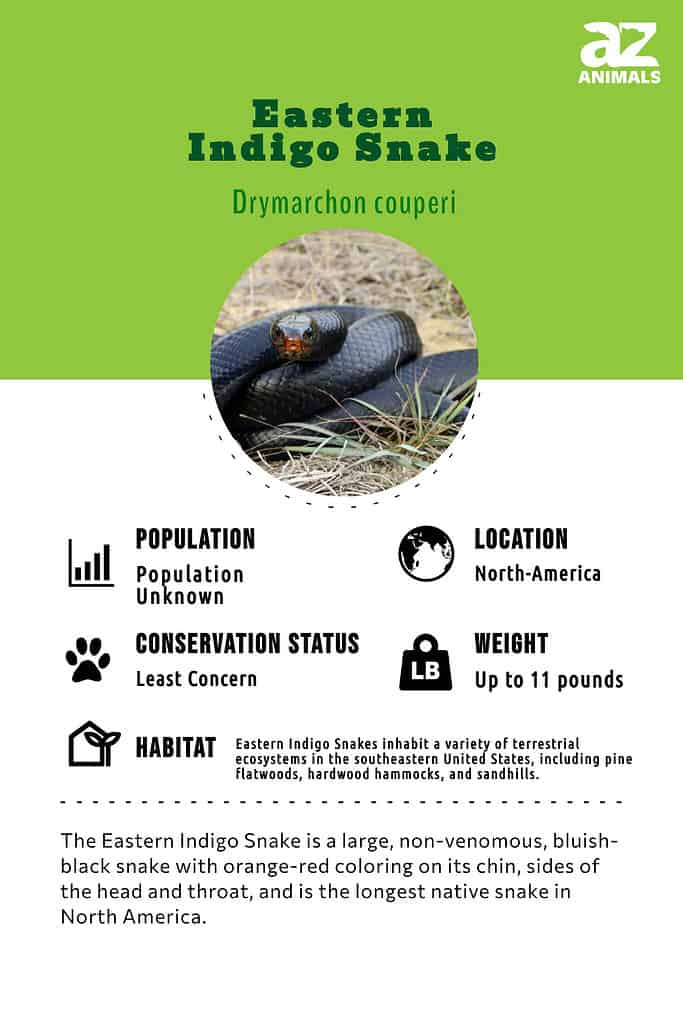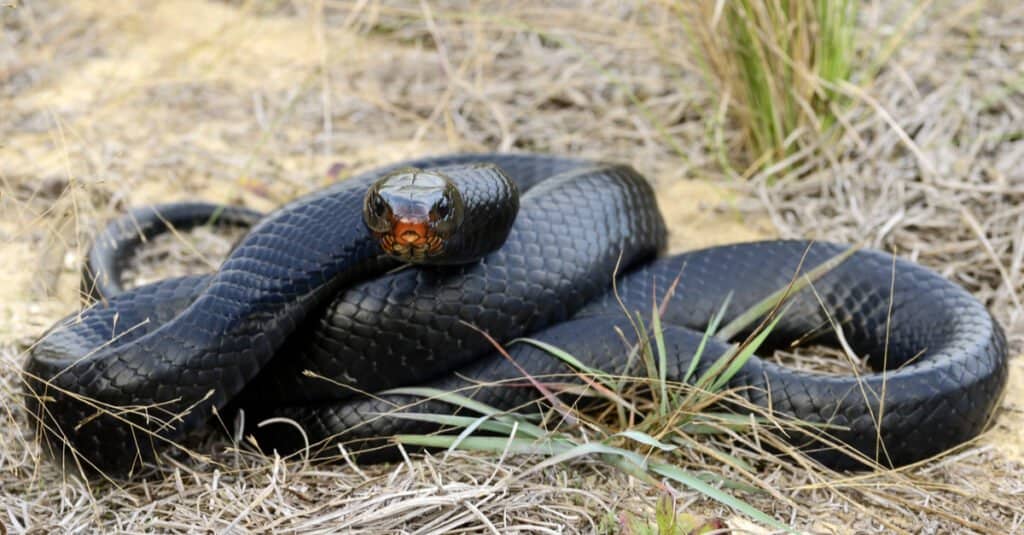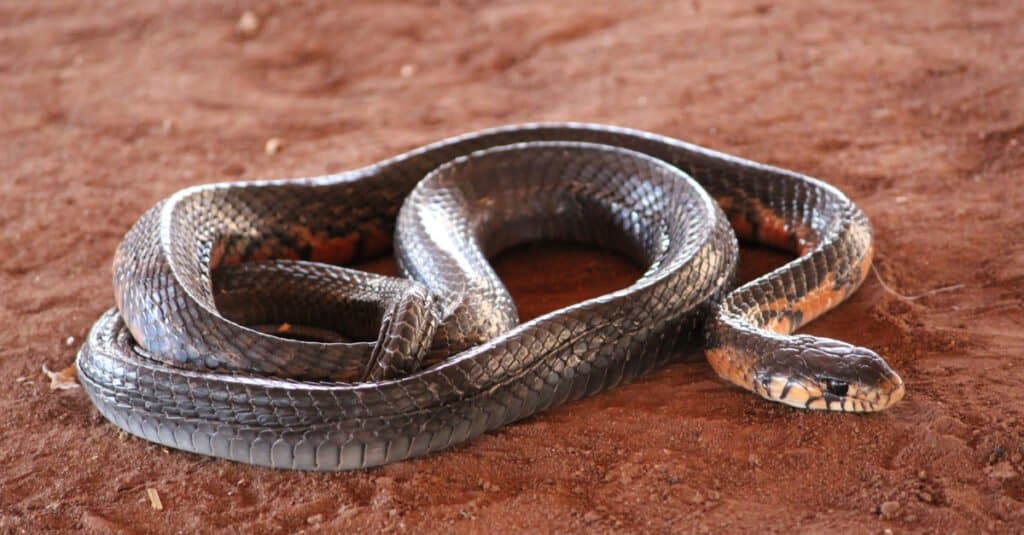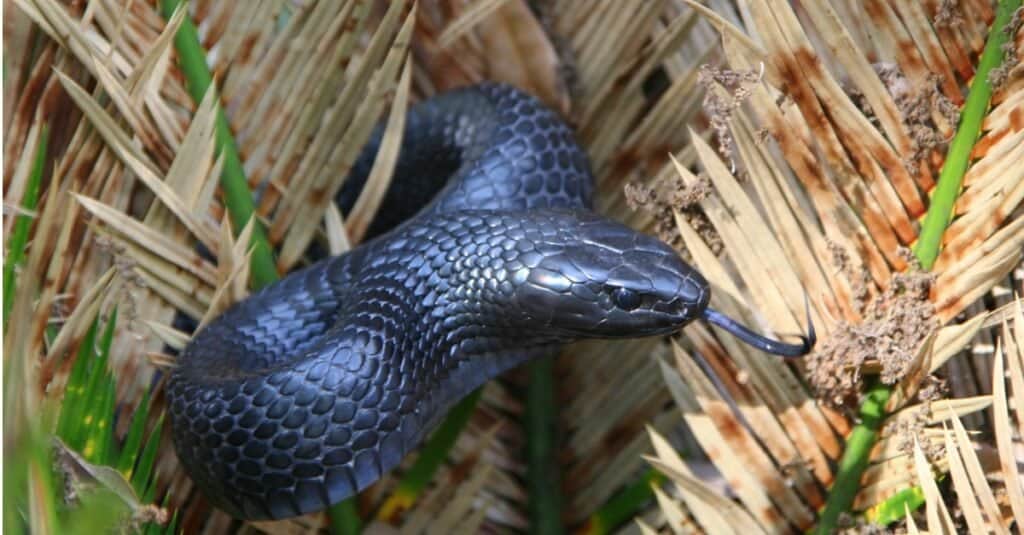Eastern Indigo Snake
Drymarchon couperi
Eastern Indigo snakes regularly chase down and eat rattlesnakes and may be immune to their venom.
Advertisement
Eastern Indigo Snake Scientific Classification
- Kingdom
- Animalia
- Phylum
- Chordata
- Class
- Reptilia
- Order
- Squamata
- Family
- Colubridae
- Genus
- Drymarchon
- Scientific Name
- Drymarchon couperi
Read our Complete Guide to Classification of Animals.
Eastern Indigo Snake Conservation Status
Eastern Indigo Snake Facts
- Prey
- Arthropods, snakes, birds, lizards, rodents
- Name Of Young
- Hatchlings
- Fun Fact
- Eastern Indigo snakes regularly chase down and eat rattlesnakes and may be immune to their venom.
- Biggest Threat
- Habitat loss
- Most Distinctive Feature
- Blue-black scales that are Iridescent purple in the light
- Other Name(s)
- Gulf Coast Indigo Snake, Indigo Snake, Racer
- Litter Size
- 4-12
- Diet for this Fish
- Carnivore
- Lifestyle
- Diurnal
- Favorite Food
- Venomous snakes, lizards, turtles, small mammals.
- Type
- Reptile
- Location
- Southeastern United States
View all of the Eastern Indigo Snake images!

The Eastern indigo snake is a long black nonvenomous snake that inhabits the southeastern United States.
It is the longest snake native to North America and is known for chasing down its prey, including all native venomous snakes such as copperheads and rattlesnakes. This snake is not aggressive but will defend itself by biting or releasing a foul-smelling musk. Even so, it prefers to escape over confrontation with people.
A healthy population of indigo snakes in your wilderness is a sign of a healthy ecosystem. They help keep rodent and venomous snake populations balanced and may even be resistant to rattlesnake venom. Unfortunately, they are threatened, and their range is much smaller than it once was. However, several conservation organizations are working to reintroduce them to areas where they previously lived.
Eastern Indigo Snake Amazing Facts

Eastern indigo snake (Drymarchon couperi) lyin in grass. The Eastern Indigo Snake is the longest snake in America.
©Patrick K. Campbell/Shutterstock.com
- Longest snake native to North America
- Eastern indigo snakes use brute force to subdue their prey
- There’s evidence that they may occasionally reproduce via parthenogenesis, where embryos spontaneously develop in unfertilized eggs.
- Regularly eat venomous snakes, including cottonmouths and copperheads
- Biologists have observed Eastern Indigo snakes survive rattlesnake bites and believe they may be at least somewhat immune to rattlesnake venom.
Where To Find Eastern Indigo Snake
They were once widely distributed across the southeastern United States. However, habitat loss and rattlesnake collectors have reduced their range to the Florida peninsula, southeastern Mississippi, Georgia, and southern Alabama.
They prefer to live in pine and scrubby flatwoods, sandhills, the edges of marshes, pine rocklands, dry prairie, and agricultural and other human-disturbed areas. When the temperatures dip, they seek shelter underground; those in the northern reaches of their territory hide in gopher tortoise burrows where available, but hollow logs and rodent burrows are also great shelters for them.
Scientific Name
The scientific name for the Eastern indigo snake is Drymarchon couperi . Drymarchon is Greek and roughly translates to “Lord of the Forest.” This snake is a member of the colubrid family of snakes, related to kingsnakes, but unlike kingsnakes, they are not constrictors.
Evolution and Origins
The Drymarchon couperi, also known as the eastern indigo snake, belongs to the Colubridae family and is a big, harmless species of snake found in the southeastern region of the United States.
The eastern indigo snake (Drymarchon corais couperi) is a non-poisonous, black-colored, and large snake that inhabits the southeastern United States and is known to grow up to almost 9 feet long, making it the longest native snake in the country.
- The eastern indigo is bluish-black and appears iridescent purple in the light.
- It has orange-red coloration on the chin, sides of the head, and throat.
- Males of this species can grow up to 7-9 feet in length, while females are slightly smaller.
- New hatchlings are typically between 16-24 inches long.
- The snake produces annual clutches of 6-12 eggs.
- During warmer seasons, indigos may travel up to three miles in search of new habitats and prey.
Types of Indigo Snakes
Until recently, all indigo snakes were classified as subspecies of Drymarchon corais, but genetic research revealed that there are five separate species.
Three of them occur in North America:
- D. melanurus erebennus mainly lives in south Texas and northern Mexico. It is primarily black but has some brown speckling.
- D. couperi lives in the southeastern United States.
- D. kolpobasileus This newly recognized species is endemic to the gulf coast of Florida and Mississippi. It has a shorter and shallower head shape than the Eastern indigo snake.
Two indigo snake species inhabit Central and South America:
- D. caudomaculatus lives in Venezuela and Colombia and has more brown speckling than its northern cousins
- D. margaritae inhabits the Western Margarita Islands and Venezuela.
Population and Conservation Status

Eastern Indigo snakes have cream or orange-red on their cheeks, chin, and throat.
©Alan Jimenez G/Shutterstock.com
The U.S. Fish & Wildlife Services listed Eastern Indigos as threatened in 1978, but IUCN lists them as least concerned. Indigo populations are connected to gopher tortoises and their burrows because they and other snake species such as rattlesnakes also use gopher tortoise burrows.
Rattlesnake hunters gassed burrows, where they pour gasoline into them to flush out rattlesnakes, but the practice is often fatal to all animals in the burrow. Gassing killed many animals and decimated the Eastern indigo snake and gopher tortoise populations.
Efforts are underway to help restore the Eastern indigo snake and gopher tortoise to the wild. At the Orianne Center for Indigo Conservation (OCIC), a captive breeding program released 169 eastern indigo snakes in the Conecuh National Forest in southern Alabama between 2010 and 2019, and 47 between 2017 and 2019 in the Nature Conservancy’s Apalachicola Bluffs and Ravines Preserve in the Florida Panhandle.
How To Identify Eastern Indigo Snakes: Appearance and Description

The eastern indigo snake is a large nonvenomous snake native to the Eastern United States. Its head and body are about the same size, and it doesn’t have much of a neck.
©iStock.com/sstaton
It is the longest snake native to North America, and males regularly reach 7-9 feet, females are slightly shorter, and hatchlings measure 17-24 inches long.
It is a long, somewhat thin snake with large smooth blue-black scales that are iridescent purple in the light; some have cream or orange-red on their cheeks, chin, and throat. Its head and body are about the same size, and it doesn’t have much of a neck.
How Dangerous Are Eastern Indigo Snakes?
Eastern indigo snakes are not dangerous to humans or pets. They tend to avoid direct contact whenever they can and are not aggressive. However, if startled they’ll bite (and they have a strong bite!) and release a foul-smelling musk from their cloaca.
Behavior and Humans
Eastern indigos are fast-moving snakes that often chase down their prey. They are helpful snakes that help control rodent and venomous snake populations. Unlike other members of the Colubridae family, like kingsnakes, they do not constrict their prey. Instead, they suffocate it using their very strong bite and pinning it against a hard surface.
They use the burrows of other animals to thermoregulate (control their body temperature). When the winter temperatures dip too far for comfort, they hibernate in burrows to keep a little warmer; when the summer is too hot, they go underground to cool off a bit.
It’s the beauty of underground burrows – they maintain a more stable temperature all year long allowing ectothermic reptiles like eastern indigo snakes to control their body temperature.
Similar Animals
View all 117 animals that start with EEastern Indigo Snake FAQs (Frequently Asked Questions)
Are they venomous?
No, and they are not dangerous to people or pets.
How do they hunt?
Brute force is the name of their game. They chase down their prey and overpower it, often holding it in their jaws and pinning it against a hard surface.
Are eastern indigos aggressive?
No. They prefer to avoid confrontation and are more likely to flee than fight. That said, they will bite if they’re cornered and can release an awful stench!
Where do eastern indigos live?
They used to live all across the southeastern United States, but now mainly survive in the Florida peninsula and southeast Georgia, and have a small population in the Florida Panhandle.
What do eastern indigos eat?
They like venomous snakes like rattlesnakes, copperheads, and cottonmouths, but often eat turtles, mammals, frogs, birds, and lizards.
Are eastern indigos found in Alabama?
Eastern indigos were absent from Alabama for a long period but have recently returned! In 2022, there was just the second sighting of an eastern indigo in the state in the past 60 years. It’s likely the snake is once again breeding within Alabama’s borders thanks to conservation efforts.
Thank you for reading! Have some feedback for us? Contact the AZ Animals editorial team.
Sources
- Everglades / Accessed February 15, 2022
- Smithsonian's National Zoo & Conservation Biology Institute / Accessed February 15, 2022
- Central Florida Zoo & Botanical Gardens / Accessed February 15, 2022
- The Nature Conservancy / Accessed February 15, 2022
- National Library of Medicine / Accessed February 15, 2022
- IUCN / Accessed February 15, 2022


















